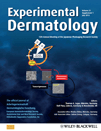
EXPERIMENTAL DERMATOLOGY
Scope & Guideline
Unveiling Innovations in Dermatological Research
Introduction
Aims and Scopes
- Clinical Dermatology:
Research focusing on the diagnosis, treatment, and management of skin diseases, including common conditions like psoriasis, eczema, and acne. - Experimental Dermatology:
Studies investigating the underlying mechanisms of skin diseases at a molecular and cellular level, including the role of immune responses and genetic factors. - Innovative Therapies:
Exploration of new treatment modalities, including biologics, small molecules, and novel therapeutic approaches for skin conditions. - Psychodermatology:
Research examining the intersection of mental health and dermatological conditions, understanding how psychological factors affect skin disorders. - Patient-Centric Studies:
Investigations into patient experiences, satisfaction, and quality of life related to dermatological treatments and conditions. - Epidemiology and Public Health:
Studies assessing the prevalence, risk factors, and public health implications of skin diseases across diverse populations. - Teledermatology and Digital Health:
Research on the use of telemedicine and digital tools in dermatology, particularly in the context of patient management and education.
Trending and Emerging
- Artificial Intelligence in Dermatology:
An increasing number of studies explore the application of AI technologies for diagnosing skin conditions, enhancing clinical decision-making, and improving patient outcomes. - Biologics and Targeted Therapies:
There is a growing focus on the efficacy and safety of biologic treatments for chronic skin conditions, particularly psoriasis and atopic dermatitis, reflecting advancements in personalized medicine. - Impact of COVID-19 on Skin Health:
Research addressing the dermatological implications of COVID-19, including vaccine-related skin reactions and the psychosocial effects of the pandemic on patients with skin conditions. - Sustainability in Dermatology:
Emerging interest in sustainable practices within dermatology, including eco-friendly treatment approaches and considerations for reducing environmental impact. - Telemedicine and Remote Care:
The use of teledermatology has surged, with studies examining its effectiveness and patient satisfaction, especially during and after the COVID-19 pandemic. - Psychodermatology:
An increased focus on the psychological aspects of dermatological conditions, emphasizing the need for integrated care that addresses both physical and mental health.
Declining or Waning
- Traditional Surgical Techniques:
Research on conventional surgical methods for skin lesions has decreased as interest in minimally invasive techniques and novel therapies rises. - Basic Science without Clinical Application:
Studies focusing solely on basic science without direct relevance to clinical practice are becoming less frequent as the emphasis shifts towards translational research. - Single-Center Studies:
There is a noticeable reduction in the number of single-center studies, with a growing preference for multicenter and collaborative research efforts. - Historical Perspectives:
Research articles that focus on historical aspects of dermatology have seen a decline in popularity, as contemporary clinical challenges take precedence. - Pharmacological Reviews:
While pharmacological studies are still relevant, comprehensive reviews of existing medications are becoming less common, replaced by studies focusing on new treatment paradigms.
Similar Journals

AUSTRALASIAN JOURNAL OF DERMATOLOGY
Elevating dermatological research and practice.Australasian Journal of Dermatology is a leading publication in the field of dermatology, issued by Wiley since 1951, and reaching an audience of researchers, clinicians, and students interested in the latest advancements and practices in skin health. With an ISSN of 0004-8380 and an E-ISSN of 1440-0960, this journal stands out with its Q2 ranking in both Dermatology and Miscellaneous Medicine, positioning it within the top 61st percentile of its category according to Scopus. Although it does not provide Open Access options, Australasian Journal of Dermatology is committed to disseminating high-quality research that informs clinical practices and promotes scholarly dialogue. By publishing rigorous and peer-reviewed articles focused on various aspects of dermatological science, the journal plays a pivotal role in enhancing the dermatology community's understanding of skin conditions and treatments, making it an invaluable resource for professionals and students alike.

Dermatologica Sinica
Elevating Dermatology: Where Research Meets Real-world ImpactDermatologica Sinica, published by Wolters Kluwer Medknow Publications, is an esteemed open-access journal in the field of dermatology that has been disseminating critical research since its inception in 2005. With an E-ISSN of 2223-330X and an ISSN of 1027-8117, this journal presents a platform for researchers, clinicians, and students to share cutting-edge findings and advancements in dermatological science. As of 2023, it proudly ranks in the Q2 category of dermatology journals and holds a notable position at rank #62 out of 142 in the Scopus Medicine - Dermatology category, placing it in the 56th percentile for impact. The journal transitioned to an open-access model in 2016, enhancing accessibility and visibility for groundbreaking studies worldwide. With a commitment to fostering innovation in the dermatological community, Dermatologica Sinica aims to advance the understanding and treatment of skin diseases while encouraging scholarly dialogue among practitioners and researchers across the globe.

ARCHIVES OF DERMATOLOGICAL RESEARCH
Pioneering Discoveries in DermatologyArchives of Dermatological Research is a premier journal dedicated to the rapidly evolving field of dermatology, published by Springer. With a distinguished history dating back to 1971 and indexed in the top quartiles (Q1 in Dermatology and Q2 in Medicine, 2023), this journal serves as a vital resource for researchers, clinicians, and students alike. It publishes innovative findings, critical reviews, and comprehensive studies that advance our understanding of dermatological conditions and treatments. The journal's commitment to disseminating high-quality research in a field crucial to public health emphasizes the importance of advancing knowledge in skin science and therapy. For those looking to explore significant advancements in dermatology, Archives of Dermatological Research offers an invaluable platform for scholarly discourse and knowledge exchange, though it is not an Open Access journal. Based in Germany, this publication attracts a global audience and remains at the forefront of dermatological research until its anticipated converged years reaching 2024.

Acta Dermatovenerologica Croatica
Bridging Knowledge Gaps in Dermatology and VenereologyActa Dermatovenerologica Croatica is a premier journal dedicated to the fields of dermatology and venereology, published by the Croatian Dermatovenereological Society. Established in 1994, this journal has been a vital platform for disseminating research and advancements in the understanding and treatment of skin diseases and sexually transmitted infections. Although it is currently classified in the Q4 quartile for dermatology, infectious diseases, and miscellaneous medicine, it provides a unique opportunity for emerging researchers and seasoned professionals to contribute to a growing body of knowledge. Based in Zagreb, Croatia, the journal emphasizes free access to information that enhances clinical practices and scientific understanding among dermatologists and venereologists worldwide. As the journal approaches its 30th anniversary, it continues to aim for excellence in research quality, fostering collaboration, and innovating in the ever-evolving fields it represents.

CLINICAL AND EXPERIMENTAL DERMATOLOGY
Transforming Clinical Insights into Experimental Breakthroughs.CLINICAL AND EXPERIMENTAL DERMATOLOGY is a prominent journal in the field of dermatology, published by Oxford University Press. With an ISSN of 0307-6938 and an E-ISSN of 1365-2230, this journal has been a vital resource for researchers and practitioners since its inception in 1976. Recognized as a Q2 journal within the category of dermatology for 2023, it holds a respectable position, ranking #54 among 142 journals in this discipline, placing it in the 62nd percentile on Scopus. The journal is dedicated to publishing high-quality research that spans clinical and experimental aspects of dermatological science, making it an essential source of knowledge for advancing understanding and treatment of skin disorders. Although it operates on a traditional subscription model without open access options, its contributions to the field are significant, influencing both clinical practices and academic research. Researchers, clinicians, and students alike will find vital insights and contemporary themes presented in its pages, supporting ongoing education and innovation in dermatology.

Journal of Egyptian Womens Dermatological Society
Transforming Women's Health Through Dermatological ScholarshipThe Journal of Egyptian Women's Dermatological Society, published by Wolters Kluwer Medknow Publications, is an essential platform dedicated to advancing the field of dermatology through a valuable focus on women's health issues. Established to provide an open access outlet since 2019, this journal aims to disseminate research, case studies, and reviews that address the unique dermatological needs and concerns of women, particularly in the Egyptian context. Despite its current ranking in the Q4 category in dermatology and a Scopus rank of #117 out of 142 with a 17th percentile, the journal serves a critical role in fostering scholarly communication among researchers, clinicians, and academicians. With a commitment to promoting knowledge advancement and community engagement, this journal invites submissions that align with its objectives, specifically geared towards empirical research and innovative practices in dermatology impacting women's health.

INTERNATIONAL JOURNAL OF DERMATOLOGY
Unveiling the latest in dermatological innovations.The INTERNATIONAL JOURNAL OF DERMATOLOGY, published by WILEY, stands as a premier scholarly platform in the field of dermatology, with a notable impact factor that affirms its quality and renown. Established in 1963 and converging through to 2024, this journal is recognized as a Q1 category publication, ranking in the top 20% of journals within the dermatology field according to the Scopus ranking system, where it occupies the 28th position among 142 journals. This reflects its dedication to advancing the understanding and treatment of skin diseases, making it a vital resource for researchers, healthcare professionals, and medical students alike. Although it does not provide open access options, articles published in this journal cover a broad range of dermatological topics, ensuring that it serves as a comprehensive and authoritative source for cutting-edge research and clinical practices. With its rigorous peer-review process and commitment to high standards, the INTERNATIONAL JOURNAL OF DERMATOLOGY remains indispensable for those engaged in dermatological science and practice.

Dermatologie
Elevating Dermatological Research and PracticeDermatologie, published by SPRINGER HEIDELBERG, is a prominent journal dedicated to the advancing field of dermatology. With its ISSN 2731-7005 and E-ISSN 2731-7013, this journal has established itself as a valuable resource for researchers, professionals, and students alike. Originating in Germany, the journal focuses on disseminating innovative research from 2022 to 2024, contributing significantly to the understanding of skin health and disease management. Despite its current ranking within the Q3 category in dermatology and a Scopus rank of #88/142, it provides critical insights and advances in clinical practice, epidemiology, and therapeutic modalities. With an emphasis on open discourse, it seeks to foster collaboration among healthcare professionals and researchers, thereby enhancing the quality and accessibility of dermatological research. Engage with Dermatologie to stay at the forefront of the latest advancements in skin-related health issues.

JOURNAL DER DEUTSCHEN DERMATOLOGISCHEN GESELLSCHAFT
Connecting researchers and clinicians for skin health advancements.JOURNAL DER DEUTSCHEN DERMATOLOGISCHEN GESELLSCHAFT, published by Wiley, is a prominent periodical in the field of dermatology, recognized by its Q2 quartile ranking in the 2023 dermatology category. With a dedicated focus on advancing knowledge in dermatological science, the journal publishes rigorous peer-reviewed research that encompasses a range of topics including clinical studies, research methodologies, and innovative treatment practices in dermatology. Its impact is reflected in its Scopus ranking, where it stands at #48 out of 142 in the medicine dermatology category, placing it in the top 66th percentile. Although not an Open Access journal, it serves as a critical resource for researchers, clinicians, and students alike, facilitating the dissemination of high-quality research findings and fostering a deeper understanding of dermatological conditions and treatments. With years of convergence from 2003 to 2024, this journal remains a vital platform for scholarly dialogue and discovery in dermatology.

JAMA Dermatology
Connecting Clinicians and Researchers for Impactful Insights.JAMA Dermatology, an esteemed publication by the American Medical Association, is positioned at the forefront of dermatological research and clinical practice. With an ISSN of 2168-6068 and an E-ISSN of 2168-6084, this journal underscores a commitment to disseminating high-quality and impactful research within the field. Notably ranked Q1 in both Dermatology and Miscellaneous Medicine for 2023, JAMA Dermatology ranks among the top journals in its category, holding the impressive 3rd position out of 142 in Scopus's dermatology rankings, placing it in the 98th percentile. With converged years extending from 2013 to 2024, the journal emphasizes timely and critical advancements in dermatological science. Furthermore, as a champion of open access, it encourages a broad dissemination of knowledge, making essential research accessible to a wider audience. Researchers, professionals, and students alike will find JAMA Dermatology to be an invaluable resource for the latest findings, innovative therapies, and in-depth reviews that shape the future of dermatological health.